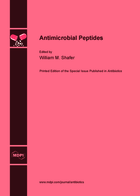Antimicrobial Peptides
A special issue of Antibiotics (ISSN 2079-6382).
Deadline for manuscript submissions: closed (31 August 2014) | Viewed by 156431
Special Issue Editor
Special Issue Information
Dear Colleagues,
This issue of Antibiotics is dedicated to the topic of antimicrobial peptides (AMPs), which are now recognized as important mediators of innate defense against microbial infections. Primary research manuscripts and review articles dealing with AMPs that emphasize their structure-function, biosynthesis and regulation, evolution, contribution to host defense, immune-modulatory activities, contributions to the pathophysiology of diseases, development of AMPs as therapeutic agents or mechanisms of action, as well as systems used by microbes to resist their antimicrobial action and how such resistance contributes to microbial pathogenesis, are invited.Submitted manuscripts will be peer-reviewed to ensure that the issue contains high quality contributions. Collectively, this issue will provide the readership with the most up-to-date information on AMPs.
Dr. William M. Shafer
Guest Editor
Manuscript Submission Information
Manuscripts should be submitted online at www.mdpi.com by registering and logging in to this website. Once you are registered, click here to go to the submission form. Manuscripts can be submitted until the deadline. All submissions that pass pre-check are peer-reviewed. Accepted papers will be published continuously in the journal (as soon as accepted) and will be listed together on the special issue website. Research articles, review articles as well as short communications are invited. For planned papers, a title and short abstract (about 100 words) can be sent to the Editorial Office for announcement on this website.
Submitted manuscripts should not have been published previously, nor be under consideration for publication elsewhere (except conference proceedings papers). All manuscripts are thoroughly refereed through a single-blind peer-review process. A guide for authors and other relevant information for submission of manuscripts is available on the Instructions for Authors page. Antibiotics is an international peer-reviewed open access monthly journal published by MDPI.
Please visit the Instructions for Authors page before submitting a manuscript. The Article Processing Charge (APC) for publication in this open access journal is 2900 CHF (Swiss Francs). Submitted papers should be well formatted and use good English. Authors may use MDPI's English editing service prior to publication or during author revisions.
Keywords
- antimicrobial peptides
- evolution, molecular biology
- regulation
- synthesis
- structure-function
- host defense
- bacterial diseases
- immune-modulation
- inflammation







